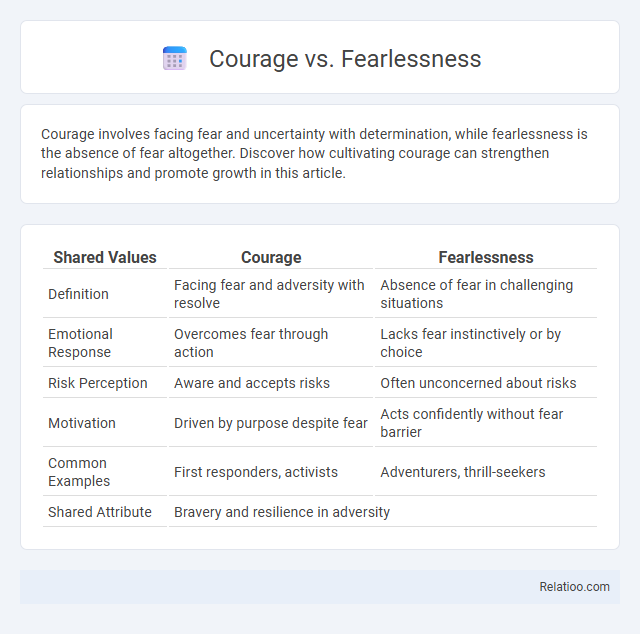Courage involves facing fear and uncertainty with determination, while fearlessness is the absence of fear altogether. Discover how cultivating courage can strengthen relationships and promote growth in this article.
Table of Comparison
| Shared Values | Courage | Fearlessness |
|---|---|---|
| Definition | Facing fear and adversity with resolve | Absence of fear in challenging situations |
| Emotional Response | Overcomes fear through action | Lacks fear instinctively or by choice |
| Risk Perception | Aware and accepts risks | Often unconcerned about risks |
| Motivation | Driven by purpose despite fear | Acts confidently without fear barrier |
| Common Examples | First responders, activists | Adventurers, thrill-seekers |
| Shared Attribute | Bravery and resilience in adversity | |
Understanding Courage and Fearlessness
Courage involves facing fears despite feeling apprehensive, reflecting strength in adversity and emotional resilience. Fearlessness denotes an absence of fear, often associated with recklessness rather than thoughtful bravery. Understanding courage requires recognizing it as a conscious choice to act rightly despite fear, whereas fearlessness lacks this emotional complexity and risk assessment.
Key Differences Between Courage and Fearlessness
Courage involves taking action despite feeling fear, whereas fearlessness is the absence of fear altogether. Your ability to act courageously reflects emotional strength and resilience in the face of challenges, while fearlessness suggests a lack of emotional response to potential danger. Understanding these key differences helps in recognizing how bravery and risk-taking manifest uniquely in various situations.
The Psychology Behind Courage
The psychology behind courage reveals it as the ability to confront fear and act despite experiencing anxiety, distinguishing it from fearlessness, which implies the absence of fear. Courage is a complex emotional and cognitive process involving risk assessment, moral values, and self-efficacy, enabling individuals to override fear responses. Neuroscientific studies highlight the role of the amygdala and prefrontal cortex in regulating fear and fostering courageous behavior.
What Drives Fearlessness?
Fearlessness is driven by a combination of innate temperament and learned experiences that diminish the perception of threat, allowing individuals to act without hesitation. Unlike courage, which requires conscious choice to face fear, fearlessness involves an absence or significant reduction of fear response, often influenced by genetic factors, neural pathways, and exposure to high-risk situations. This biological and psychological interplay facilitates actions uninhibited by anxiety, distinguishing fearlessness from courage in motivation and manifestation.
Real-Life Examples of Courage
True courage involves facing fear despite potential risks, as seen in firefighters entering burning buildings to save lives. Fearlessness, by contrast, implies a lack of fear altogether, which can lead to reckless decisions without assessing danger, like extreme sports athletes pushing beyond limits. Your ability to act with courage, rather than fearlessness, enables measured bravery that prioritizes safety and positive outcomes in real-life challenges.
When Fearlessness Becomes Recklessness
Fearlessness, characterized by the absence of fear, can quickly turn into recklessness when it disregards potential dangers and consequences, leading to risky and impulsive actions. Courage involves acknowledging fear but choosing to act despite it, balancing awareness with determination to overcome challenges safely. Understanding this distinction helps promote bravery grounded in wisdom rather than careless boldness.
The Benefits of Embracing Courage
Embracing courage empowers you to face challenges with resilience despite fear, fostering personal growth and emotional strength. Unlike fearlessness, which implies the absence of fear, courage acknowledges fear but chooses action regardless, leading to increased confidence and adaptability. Cultivating courage enhances decision-making, promotes risk-taking for innovation, and builds a foundation for overcoming obstacles in all areas of life.
Potential Risks of Fearlessness
Fearlessness can lead to reckless decisions by underestimating potential dangers and ignoring necessary caution, increasing the likelihood of harm or failure. Courage involves acknowledging fear and choosing to act despite it, which supports better risk assessment and informed decision-making. The absence of fear can diminish survival instincts and critical evaluation, exposing individuals to greater physical, emotional, or financial risks.
Developing Courage in Everyday Life
Developing courage in everyday life involves recognizing fear and choosing action despite it, distinguishing it clearly from fearlessness, which implies the absence of fear. Practical steps include setting small, achievable challenges that build confidence and resilience over time, harnessing mindfulness techniques to manage anxiety and enhance emotional regulation. Embracing vulnerability and learning from setbacks further solidify courage as a dynamic skill rather than an innate trait.
Choosing Between Courage and Fearlessness
Choosing between courage and fearlessness involves understanding that courage means acting despite fear, while fearlessness implies absence of fear entirely. Your ability to confront challenges grows stronger when you embrace courage, as it allows for calculated risks and personal growth. Fearlessness may seem ideal but can lead to recklessness, making courage the more pragmatic and empowering choice in difficult situations.

Infographic: Courage vs Fearlessness
 relatioo.com
relatioo.com